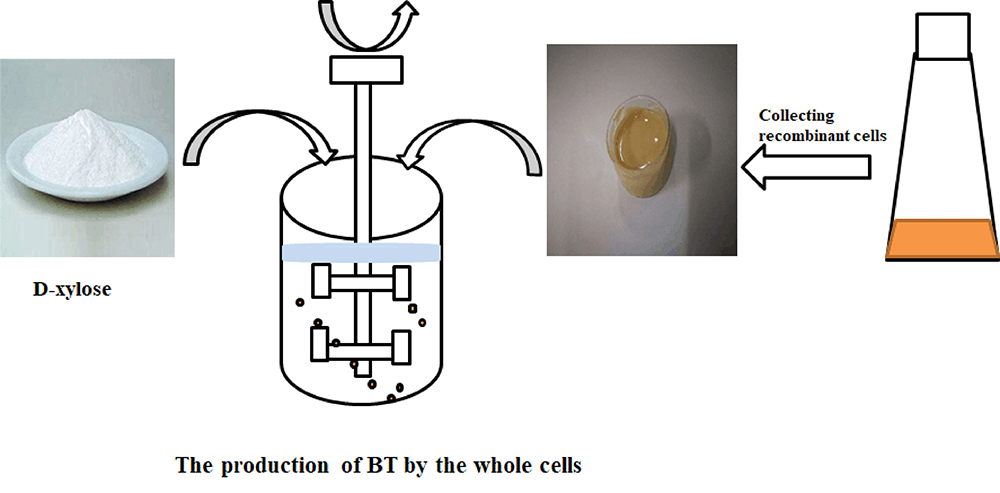

Frontiers of Chemical Science and Engineering >
Efficient production of D-1,2,4-butanetriol from D-xylose by engineered Escherichia coli whole-cell biocatalysts
Received date: 03 Feb 2018
Accepted date: 06 Apr 2018
Published date: 03 Jan 2019
Copyright
We have developed a whole-cell bioconversion system for the production of D-1,2,4-butanetriol (BT) from renewable biomass. A plasmid pETduet-xylB-yjhG-T7-adhP-T7-mdlC was constructed and transformed to Escherichia coli BL21(DE3) to obtain the whole cells of E. coli BL21-XYMA capable of bioconversion D-xylose to BT. Then, the factors including carbon sources, nitrogen sources, metal ions, and culture conditions (pH, temperature, IPTG) were identified, and their effects on the whole-cell activity for BT production were investigated. To obtain the highest whole-cell activity, the optimal cultivation parameters are: 15 g·L−1 yeast extract, 5 g·L−1 sucrose, 3 g·L−1 KH2PO4, 5 g·L−1 NaCl, 3 g·L−1 NH4Cl, 0.25 g·L−1 MgSO4∙7H2O and 1 mL·L−1 the mixture of trace elements. With the optimized whole cells of E. coli BL21-XYMA, 60 g·L−1 of xylose was converted to 28 g·L−1 BT with a molar yield of 66.0%, which is higher than those reported in the biotechnological system.

Shewei Hu , Qian Gao , Xin Wang , Jianming Yang , Nana Xu , Kequan Chen , Sheng Xu , Pingkai Ouyang . Efficient production of D-1,2,4-butanetriol from D-xylose by engineered Escherichia coli whole-cell biocatalysts[J]. Frontiers of Chemical Science and Engineering, 2018 , 12(4) : 772 -779 . DOI: 10.1007/s11705-018-1731-x
| 1 |
Sànchez Nogué V, Karhumaa K. Xylose fermentation as a challenge for commercialization of lignocellulosic fuels and chemicals. Biotechnology Letters, 2015, 37(4): 761–772
|
| 2 |
Yamada-Onodera K, Norimoto A, Kawada N, Furuya R, Yamamoto H, Tani Y. Production of optically active 1,2,4-butanetriol from corresponding racemate by Microbial stereoinversion. Journal of Bioscience and Bioengineering, 2007, 103(5): 494–496
|
| 3 |
Niu W, Molefe M N, Frost J W. Microbial synthesis of the energetic material 1,2,4-butanetriol. Abstracts of Papers of the American Chemical Society, 2004, 227: U298–U298
|
| 4 |
Xu Y, Qian L, Pontsler A V, McIntyre T M, Prestwich G D. Synthesis of difluoromethyl substituted lysophosphatidic acid analogues. Tetrahedron, 2004, 60(1): 43–49
|
| 5 |
Valdehuesa K N G, Liu H, Ramos K R M, Park S J, Nisola G M, Lee W K, Chung W J. Direct bioconversion of D-xylose to 1,2,4-butanetriol in an engineered Escherichia coli. Process Biochemistry, 2014, 49(1): 25–32
|
| 6 |
Zhang N, Wang J, Zhang Y, Gao H. Metabolic pathway optimization for biosynthesis of 1,2,4-butanetriol from xylose by engineered Escherichia coli. Enzyme and Microbial Technology, 2016, 93-94: 51–58
|
| 7 |
Cao Y, Niu W, Guo J, Xian M, Liu H. Biotechnological production of 1,2,4-butanetriol: An efficient process to synthesize energetic material precursor from renewable biomass. Scientific Reports, 2015, 5(1): 18149
|
| 8 |
Ishige T, Honda K, Shimizu S. Whole organism biocatalysis. Current Opinion in Chemical Biology, 2005, 9(2): 174–180
|
| 9 |
Bornscheuer U T, Huisman G W, Kazlauskas R J, Lutz S, Moore J C, Robins K. Engineering the third wave of biocatalysis. Nature, 2012, 485(7397): 185–194
|
| 10 |
Breuer M, Ditrich K, Habicher T, Hauer B, Kesseler M, Stürmer R, Zelinski T. Industrial methods for the production of optically active intermediates. Angewandte Chemie International Edition, 2004, 43(7): 788–824
|
| 11 |
Endo T, Koizumi S. Microbial conversion with cofactor regeneration using genetically engineered bacteria. Advanced Synthesis & Catalysis, 2001, 343(6–7): 521–526
|
| 12 |
Ogawa J, Shimizu S. Industrial microbial enzymes: Their discovery by screening and use in large-scale production of useful chemicals in Japan. Current Opinion in Biotechnology, 2002, 13(4): 367–375
|
| 13 |
Lee S Y. High cell-density culture of Escherichia coli. Trends in Biotechnology, 1996, 14(3): 98–105
|
| 14 |
Chen N, Huang J, Feng Z B, Yu L, Xu Q Y, Wen T Y. Optimization of fermentation conditions for the biosynthesis of L-threonine by Escherichia coli. Applied Biochemistry and Biotechnology, 2009, 158(3): 595–604
|
| 15 |
Amrane A, Prigent Y. Lactic acid production from lactose in batch culture: analysis of the data with the help of a mathematical model; relevance for nitrogen source and preculture assessment. Applied Microbiology and Biotechnology, 1994, 40(5): 644–649
|
| 16 |
Son H J, Heo M S, Kim Y G, Lee S J. Optimization of fermentation conditions for the production of bacterial cellulose by a newly isolated Acetobacter sp. A9 in shaking cultures. Biotechnology and Applied Biochemistry, 2001, 33(1): 1–5
|
| 17 |
Raza W, Yang X, Wu H, Huang Q, Xu Y, Shen Q. Evaluation of metal ions (Zn2+, Fe3+ and Mg2+) effect on the production of fusaricidin-type antifungal compounds by Paenibacillus polymyxa SQR-21. Bioresource Technology, 2010, 101(23): 9264–9271
|
| 18 |
Jiang Y, Liu W, Cheng T, Cao Y, Zhang R, Xian M. Characterization of D-xylonate dehydratase YjhG from Escherichia coli. Bioengineered, 2015, 6(4): 227–232
|
| 19 |
Jones P G, VanBogelen R A, Neidhardt F C. Induction of proteins in response to low temperature in Escherichia coli. Journal of Bacteriology, 1987, 169(5): 2092–2095
|
| 20 |
Sun L, Yang F, Sun H, Zhu T, Li X, Li Y, Xu Z, Zhang Y. Synthetic pathway optimization for improved 1,2,4-butanetriol production. Journal of Industrial Microbiology & Biotechnology, 2016, 43(1): 67–78
|
| 21 |
Wang X, Xu N, Hu S, Yang J, Gao Q, Xu S, Chen K, Ouyang P. d-1,2,4-Butanetriol production from renewable biomass with optimization of synthetic pathway in engineered Escherichia coli. Bioresource Technology, 2018, 250: 406–412
|
/
| 〈 |
|
〉 |